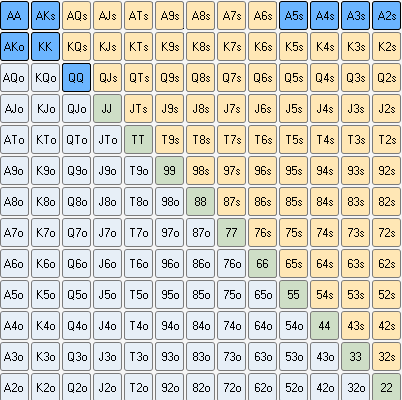The Three Bet
Oklahoma City still loses the game and the bet. What does a 7-point spread mean? A 7-point spread simply refers to the number of points posted alongside a team's odds of winning. When there is a 7-point spread, it means that the favorite team needs to win by more than 7 points to win the bet. It also means that the underdog can lose less than 7. When you bet with the spread it means you are taking the favorite to win and cover the spread. For example in the NFL the Dallas Cowboys are Favored at -3 over the Philadelphia Eagles. Taking the Dallas Cowboys -3 means you are betting with the spread and want the Cowboys to win by MORE then 3 points. Betting Against The Spread.
One of the common definitions you will hear as you play poker is '3-bet', or 'three-bet'. A 3-bet as most players use the term means the act of putting in the third bet, technically the second 'raise', the '3-bet' during any given round of action. It's only in recent years that the term has become popular, indicative of its use during online play.
- 0.75 means if Chelsea win by 1 goal, you will win half the bet. If Chelsea win by 2 goals, you win the full odds payout. Anything other than that, you lose your whole bet.
- If the odds on a tennis player said +150, that means that for a $100 bet, you would win $150. Now if there is a minus sign in front of the odds, that is the number that you would have to bet in.
- What do the + and - mean in sports betting? There are multiple meanings. The most common meaning, particularly in American football and basketball, is a point spread. If point spreads are being discussed, you might see something like 'Buffalo +7 a.
For flop games, such as hold'em and Omaha, the pre-flop 3-bet is technically different than the post-flop 3-bet. In these poker games blinds are used, and the act of posting the small and big blinds is considered the first 'bet'. Subsequent players, beginning with the 'under the gun' (UTG) player to the big blind's immediate left, have the option of calling that first bet (the amount of the big blind), or folding or raising. In a typical game, the first pre-flop raise is technically a 'two-bet', but you'll never hear it called that. Instead, it's when another play makes a second raise, going over the top of the first raiser, that the 'three-bet' term is used. Below is a visual of what a pre-flop 3-bet looks like.
In post-flop play, the 3-bet consists of an initial bet, a raise, and then a re-raise (perhaps by the initial bettor). Since the initial bet itself can be sizable, the post-flop 3-bet is proportionately larger in most instances than its pre-flop counterpart. In cash games and in the late stages of tourneys, 3-bets often involve all-in moves by one or more players, though you're just as likely to hear the words 'pushing' or 'jamming' (moving one's entire stack into the middle) in those instances.
What Does a 3-Bet Mean?
A 3-bet, which is always a form of a re-raise is designed to be an indicator of a true premium hand. The 3-bet is a shot over the bow of the initial raiser, designed to capture that pot right there. The intent of the 3-bet is to say to the initial bettor, 'Yeah, you may have a good hand, but I've got a better one.' One common variation involves the initial raise coming from a late position, the button player or the cut-off (to the button's immediate right), and the 3-bet is made by the small or big blind, who may assume the button or cutoff is attempting to steal the blinds. Overall, the 3-bet is traditionally one of the strongest moves a player can make, trailing perhaps only the all-in push and the check-raise in its ability to change a hand. It's supposed to mean that the player making the move has a very strong hand, though this being poker, that is not always the case.
Making Your Own 3-Bets
Mma fighters who started late. The use of 3-bets is best done selectively, at opportune moments. Many hyper-aggressive players 3-bet with a wide range of hands, including many garbage hands, in the nature of bluffs. Most 3-bets, however, are done with big hands.
When to 3-bet a hand and when to just call (called a 'smooth call' or 'smoothing') is one of the trickiest lessons players must learn. Knowing your opponents' tendencies is vital to success, because the best poker players play their opponents as much as their own hands. A 3-bet works best against fairly loose players, some of whom are described as 'calling stations', who simply cannot fold marginal holdings when prompted. Another successful type of 3-bet can be done against a player who might over-value the long-term prospects of the game or tourney in deference to what might happen in that specific hand. He might be surrendering a bit too much of his chance to win in hopes of getting a better opportunity in a later hand.
Then there are bluffs. The bluff type of 3-bet is called a 're-steal', and properly executed, it can be one of the most profitable moves in a player's arsenal. However, like any good play, using it too much is one of the quickest ways to go broke. Other players will eventually react to a player that is putting in too many 3-bets, and sooner or later, the player putting in those over-the-top bets will be 'looked up' (called) by his opponent. However, if you're a steady, conservative player, 3-betting an aggressive foe will work more often than you might believe. Those players are trying to steadily make small gains against your perceived, relative passivity, and when you fight back they'll often go try another door.
Defending Against the 3-Bet
Defending against the 3-bet boils down to understanding both your opponents and the circumstances of the game. Against a tight opponent who plays few hands, a 3-bet invariably means a monster and you can ditch all but the largest hands against this opponent. Even if he's on a rare bluff, his natural tendencies against bluffing should serve as a warning.
Aggressive, late-position players will often three-bet with holdings such as middle pairs, AK or AQ, and depending on your own hand, it's often correct to play or even to put the 4-bet in and take your chances. Be aware that with position and with correct 'pot odds' – referring to the relationship between the amount of money already in the pot and the total amount a player stands to win – a late-position player may be 'priced in' to making his own call with more inferior hands than you might hope.
Author:Joseph Falchetti (twitter)
(C) Copyright PokerWebsites.com, 2018
In the world of sports betting, a money line bet is simply betting on which team you expect to win. It doesn't have anything to do with a spread. You may also see a money line bet listed as 'Money Line' or 'ML' in different spaces.

Money lines are represented in negative and positive values.
Negative money line: -145, -220, or anything similar
When you see a minus (-) sign in front of a price, it shows you that team is the favorite to win the game.
That number also indicates how much money you need to bet/spend in order to win $100.
For example, a -220 money line means you need to bet $220 in order to win $100 provided the team you bet on actually does win.
Heavy favorites are known in sports betting as a 'chalk' pick. A heavy favorite usually has a number pushing +300 or more. Here, you're wagering a lot on the favorite to win a little. Don't assume that a heavy favorite, or chalk pick, is a guaranteed winner…
Positive money line: +145, +220, or anything similar
When you see a plus (+) sign in front of a price, it shows you that team is the underdog. Higher numbers like +400, +500, +5000, etc. represent how much of an underdog the team is in the game. The higher the number the more likely the team is expected to lose in the eyes of the oddsmakers.
The number also indicates how much money would win in comparison to every $100 you wager.

For example, a +150 money line means you would win $150 for each $100 wager you place should that team win the game.
Money line examples:
Lets use an NFL example here:
New England Patriots -240
Miami Dolphins +220
To bet the New England Patriots to win on the money line, you would need to spend $240 on the bet for a chance to win $100 if the Patriots beat the Dolphins. Your return would be $340 – the original $240 stake (bet) and the $100 bet profit.
What Does +100 Mean In Betting
To bet the Miami Dolphins to win on the money line, you would spend $100 on the bet for a chance to win $220 if the Dolphins, as the underdog, beat the Patriots. Your return would be $320 – the original $100 stake (bet) and the $220 profit.

Money lines are represented in negative and positive values.
Negative money line: -145, -220, or anything similar
When you see a minus (-) sign in front of a price, it shows you that team is the favorite to win the game.
That number also indicates how much money you need to bet/spend in order to win $100.
For example, a -220 money line means you need to bet $220 in order to win $100 provided the team you bet on actually does win.
Heavy favorites are known in sports betting as a 'chalk' pick. A heavy favorite usually has a number pushing +300 or more. Here, you're wagering a lot on the favorite to win a little. Don't assume that a heavy favorite, or chalk pick, is a guaranteed winner…
Positive money line: +145, +220, or anything similar
When you see a plus (+) sign in front of a price, it shows you that team is the underdog. Higher numbers like +400, +500, +5000, etc. represent how much of an underdog the team is in the game. The higher the number the more likely the team is expected to lose in the eyes of the oddsmakers.
The number also indicates how much money would win in comparison to every $100 you wager.
For example, a +150 money line means you would win $150 for each $100 wager you place should that team win the game.
Money line examples:
Lets use an NFL example here:
New England Patriots -240
Miami Dolphins +220
To bet the New England Patriots to win on the money line, you would need to spend $240 on the bet for a chance to win $100 if the Patriots beat the Dolphins. Your return would be $340 – the original $240 stake (bet) and the $100 bet profit.
What Does +100 Mean In Betting
To bet the Miami Dolphins to win on the money line, you would spend $100 on the bet for a chance to win $220 if the Dolphins, as the underdog, beat the Patriots. Your return would be $320 – the original $100 stake (bet) and the $220 profit.
What Does -3 Point Spread Mean In Betting
Most mma fights in a career. In both situations, it doesn't matter if the team you bet on wins by one point or 100 points. You're purely betting on the team you believe will win the game. As Al Davis said, 'Just win, baby.' That's exactly what you'd be looking for out of your selection. It doesn't have to be pretty, it just has to happen or your original stake is lost.

